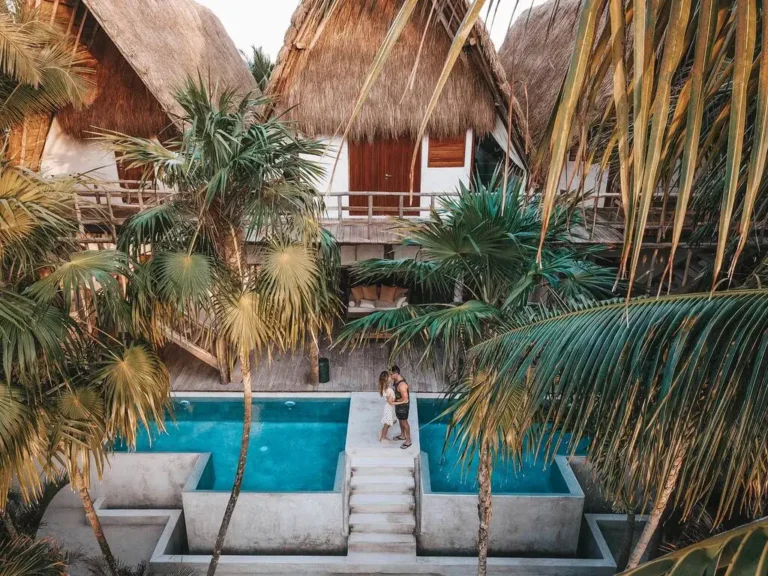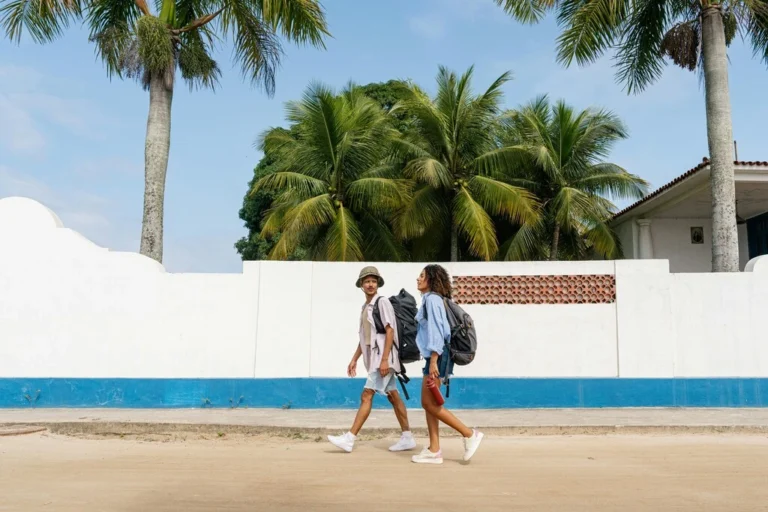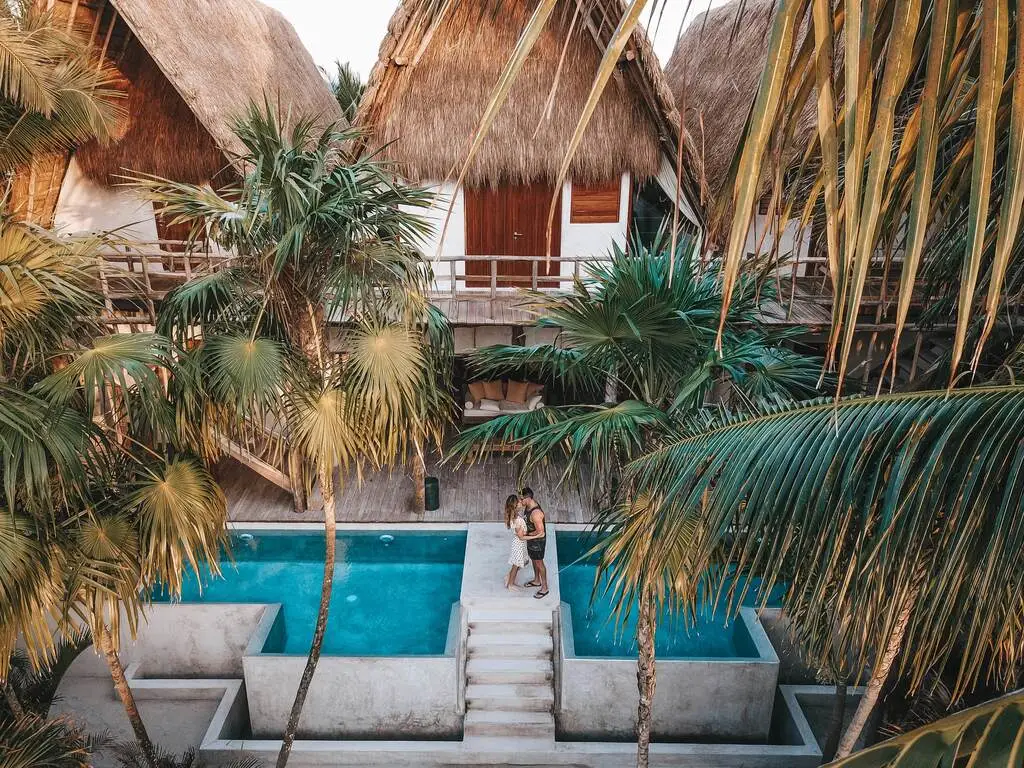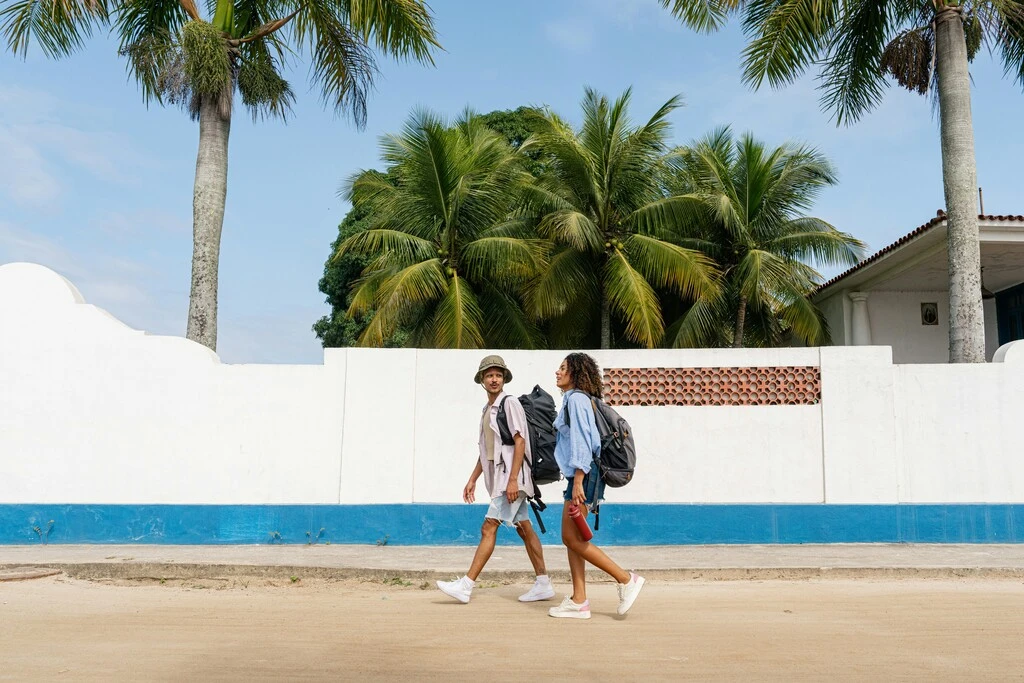Updated in January 2025!
We are often asked whether you have to be rich to become a digital nomad. After all, traveling is expensive, especially with children.
My answer is quite clear: no, you don’t have to be rich. However, you should have a sufficient financial cushion, realistic expectations, and sustainable income streams, especially if you are traveling with the whole family.
So, what is the ideal digital nomad budget? How much should you have saved up before you set off, and what cost of living can you expect when you’re on the road?
We will discuss all of this in this article.

Setting up as a Digital Nomad Family – Initial Costs
First of all, you’ll get a confession from me: when we left Germany as a family of three in 2019 and booked a one-way ticket to Thailand, we really had hardly any savings. We set off with a digital nomad budget of just $10,000. And that’s the bare minimum I recommend.
My personal formula is: you should have enough money to survive comfortably for at least 3 months while traveling and also be able to buy tickets back to your home country.
In our case, this was exactly right, as you can live cheaply in Thailand, and the flight prices were even cheaper at the time.
Today, with two children, a different lifestyle, and higher flight prices, we would need twice as much.
But let’s take a closer look at the initial costs. In other words, all the costs incurred in order to be equipped for the digital nomad lifestyle in the first place.
1. Tech and Gadgets
Depending on what you do for a living, you may need equipment to continue doing your job on the road. This includes, for example, a laptop, smartphone, noise-canceling headphones, backup storage, cables, and a multi-function travel adapter.
Content creators will also need camera equipment.
Here is a current equipment price list (January 2025):
- Apple MacBook Air, 13 inch: $1099
- Apple iPhone 16: from $799
- Lacie 1TB external hard drive: $100
- Bose Quiet Comfort Headphones: $349
- Mogics Power Donut & Bagel: $49
___________________________________
Total: $2,396
Please do not forget to add costs for necessary software subscriptions to your digital nomad budget to have a long-term overview.

2. Insurance
Depending on how much security you need, you will, of course, need appropriate insurance. I’m not the biggest fan of insurance, but I think one is indispensable: travel health insurance. I just can’t preach it often enough; if anything happens on the road, be it to you or your children, then good health insurance is worth so much.
In 2019, we chose travel health insurance with the German insurance company Hanse Merkur. Our tariff for two adults and two children cost around $200 per month. After 5 years, Hanse Merkur didn’t extend our insurance, so I had to find another insurance provider for our family.
I wrote an article about the health insurance search process with many useful comparisons.
3. Visas and Documentation
Preparing all the necessary documents also costs money. Here is a list of documents you should have with you, divided into original and copy.
Original:
- Passport
- Driving license (local and international)
- Marriage or divorce certificate, if applicable
- Vaccine passport
- Birth certificates of kids, if applicable
Copy:
- Travel and medical insurance policies
- Bank statements and other relevant papers from your bank
- Residency confirmation
When it comes to visas, I have set up an example here: For a family of four planning to stay in Thailand for three months, the cost of the visa will depend on the type of visa you apply for.
The most suitable option for a three-month stay is likely the Tourist Visa. Here are the relevant costs:
- Single-entry Tourist Visa (valid for 60 days, extendable for an additional 30 days):
- Cost per person: Approximately $30
- Total for four people: $120
- Extension fee (for an additional 30 days, after the initial 60 days):
- Cost per person: Approximately $60
- Total for four people: $240
___________________________________
Total: $360

4. Vaccinations
Digital nomads planning to travel to Southeast Asia should consider getting the following vaccinations to protect against common diseases in the region: Depending on where you are planning to travel, you will need different vaccinations.
If we take our family traveling to Thailand as an example, the following vaccinations are recommended by the WHO:
- Hepatitis A and B:
- Hepatitis A is transmitted through contaminated food and water. $50 – $100 per dose (2 doses required)
- Hepatitis B is transmitted through blood and other bodily fluids. $40 – $75 per dose (3 doses required)
- Combined vaccines for both Hepatitis A and B are available. $75 – $150 per dose (3 doses required)
- Typhoid:
- Typhoid fever is spread through contaminated food and water.
- Vaccination is recommended, especially if you are staying with friends or relatives, visiting smaller cities or rural areas, or have an adventurous eating style. $50 – $150
- Tetanus, Diphtheria, and Pertussis (Tdap):
- Tetanus can be contracted through cuts or wounds.
- Pertussis (whooping cough) is a highly contagious respiratory disease.
- A Tdap booster is recommended every 10 years. $45 – $85
- Measles, Mumps, and Rubella (MMR):
- Ensure you are up to date with the MMR vaccine.
- Two doses of the MMR vaccine are recommended for those born after 1956 who have not had the diseases. $75 – $120 per dose (2 doses required)
- Polio:
- Ensure you have completed the polio vaccination series.
- An adult booster is recommended for certain travel destinations. $40 – $60 per dose
- Japanese Encephalitis:
- Recommended if you plan to spend a significant amount of time in rural areas, especially for long-term stays.
- Japanese Encephalitis is transmitted through mosquito bites. $300 – $450 for the series (2 doses required)
- Rabies:
- Consider the rabies vaccine if you will be involved in activities that could bring you into direct contact with animals, such as camping or biking. $200 – $400 per dose (3 doses required)
- Influenza:
- The flu vaccine is recommended, especially if you are traveling during flu season. $20 – $50 per dose
- Malaria Prophylaxis:
- There is no vaccine for malaria, but prophylactic medications can prevent it.
- Malaria is present in some parts of Southeast Asia. Malaria medications:
- Atovaquone/Proguanil (Malarone): $3 – $6 per pill
- Doxycycline: $0.50 – $3 per pill
- Mefloquine (Lariam): $5 – $11 per pill
___________________________________
Total: $2,000
We were lucky that our statutory health insurance in Germany at the time covered the costs of almost all vaccinations. We only had to pay about $500 per person ourselves. That was a great relief for our digital nomad budget.
Check my article on the most important vaccines for Thailand travel here.

5. The Costs of a Sustainable Income System
This point should not be forgotten either. Because if you have to set up a professional system for your life as a digital nomad, that will also cost money. By this, I mean the cost of setting up a company, for example, or getting advice from good tax advisors, etc. In our case, these were:
- Costs for setting up an American LLC: approx. $6,000
- Tax advice in Germany and the USA: approx. $500
___________________________________
Total: around $6,500
I highly recommend the services of Denationalize and Taxhackers. Here, you get the all-inclusive package to minimize your tax burden as much as possible in the future.
(Please note that in 2019, we used another company to set up this company construct, but I won’t recommend them as we weren’t completely satisfied).
Read everything about digital nomad taxes in this article.
Digital Nomad Budget: Monthly Living Expenses
Monthly expenses are very individual, I know. Some people love to cook at home, while others usually eat out. Some can manage with a simple bungalow, while others need a house with a pool.
Moreover, the cost of living also varies greatly from country to country.
To make this section as clear as possible for you, I have listed our current cost of living in Koh Phangan, Thailand, in January 2025. Here you can also find our cost of living in Koh Tao, Canggu and Ubud.
Monthly Cost of Living in Koh Phangan
🏠 Housing: 49,000 THB ($1,442) – 2-bedroom house in Sri Thanu (incl. electricity, 7 THB/Unit and cleaning)
🛒 Groceries: 10,300 THB ($301) – mostly at supermarkets and local markets
🥗 Restaurants: 57,000 THB ($1,548) – mostly Western food
🛵 Transportation: 19,100 THB ($562) – we own 2 scooters and rent one car
👶 Childcare/Education: 55,000 THB ($1,490) – school and kindergarten, plus playground and occasional nanny
🏋️ Sports: 8,500 THB ($230) – gym and yoga classes
💆♀️ Personal Care: 12,690 THB ($344) – massages, nails, and barber
🥳 Fun & Activities: 22,000 THB ($597) – e.g., waterparks, museums, diving, kids’ experiences
__________________________
Total: 233,590 THB = $6,876
The costs are pretty high, don’t you think? And we’re lucky because here in the south of Thailand the schools are very cheap. If you want to send your child to an international school in Bangkok or Phuket, you can expect to pay double, if not triple, the price.
In this article, I have listed the cost differences between solo travel and traveling with kids.

Budgeting Methods for Digital Nomads
Now you know what you can expect in terms of costs if you want to start out as a digital nomad. You also have a rough overview of the cost of living for a family of four in Thailand in 2024. But what you still need are tips on how to manage money while traveling.
Here are some of the most common budgeting techniques:
1. Zero-Based Budgeting
- Description: Every dollar is assigned a purpose, so the income minus expenses equals zero. This method forces you to justify each expense.
- Advantages: Helps identify and eliminate unnecessary expenses.
- Example: If you earn $3,000 a month, every dollar is allocated to specific expenses, savings, or debt repayments until there is no unallocated money left.
2. 50/30/20 Rule
- Description: Divides your after-tax income into three categories: 50% for needs, 30% for wants, and 20% for savings and debt repayment.
- Advantages: Simple and easy to implement, promotes a balanced financial life.
- Example: If your after-tax income is $4,000, you would allocate $2,000 to needs, $1,200 to wants, and $800 to savings and debt repayment.
3. Envelope System
- Description: Cash is divided into envelopes for different spending categories. Once the cash is gone, no more spending in that category is allowed.
- Advantages: Helps in controlling overspending and encourages sticking to the budget.
- Example: Allocate $300 for groceries, $200 for dining out, $100 for entertainment, etc. Each category has its own envelope with cash.
4. Pay Yourself First
- Description: Prioritizes savings and investments by setting aside money before paying for other expenses.
- Advantages: Ensures consistent savings and investments, helping to build wealth over time.
- Example: Automatically transfer 20% of your income to a savings or investment account before spending on anything else.
5. Line-Item Budget
- Description: Breaks down the budget into individual line items, detailing every expected expense and income source.
- Advantages: Provides detailed insight into spending habits and helps track where every dollar goes.
- Example: List every expense such as rent, utilities, groceries, insurance, and entertainment with specific amounts allocated to each.
6. Reverse Budgeting
- Description: Focuses on saving first by determining the amount you want to save each month, then budgeting the rest of your expenses with what’s left.
- Advantages: Ensures savings goals are met and reduces the temptation to overspend.
- Example: If your goal is to save $500 per month, allocate this amount to savings first and then budget the remaining $3,500 for other expenses.
7. Priority-Based Budgeting
- Description: Allocates funds based on priority, ensuring the most important expenses and goals are covered first.
- Advantages: Aligns spending with personal values and financial goals.
- Example: Prioritize essential bills and debt payments, followed by savings and discretionary spending.
8. The Anti-Budget
- Description: Instead of tracking every expense, focus on saving a predetermined amount each month, and spend the rest freely.
- Advantages: Simplifies budgeting for those who dislike detailed tracking.
- Example: Decide to save $1,000 every month, and use the remaining income for all other expenses without detailed budgeting.
We use Spending Tracker – Budget app to track all our expenses. At first it feels strange to track every single expense, but you get used to it very quickly.
👉 You might also find these articles interesting:
– How to Travel Around The World and Make Money
– Digital Nomad Taxes: All You Need to Know
– 20 Remote Work-From-Home Jobs With No Experience Needed
– How to Become a Digital Nomad Copywriter
Final Thoughts on the Digital Nomad Budget
To come back to the opening: No, you really don’t have to be rich to lead a life as a digital nomad family. But you definitely need to have a good grip on your budget and be prepared for emergencies.
Did this article help you? Do you have any questions? Let me know in the comments!
Thanks for reading and for making me part of your day! Yours, Lulu
Just a heads up: some links in the article “Digital Nomad Budget” on Nomadmum.com are affiliate links. This means if you click and buy, I might earn a small commission at no extra cost to you.






